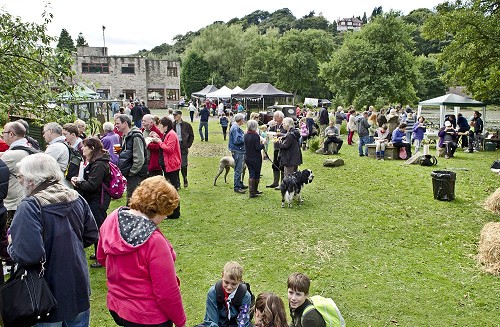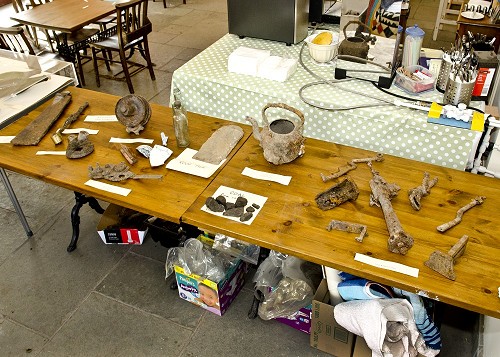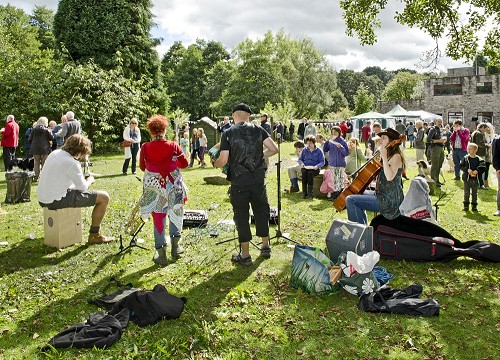Mellor Mill Heritage Day, Sunday, 8th September
Mellor Mill Heritage Day

Sunday September 8th, 2013
Fact & Fun at the Roman Lakes
2013
The long wait was over for those working behind the scenes to create the Mellor Mill Heritage Day, at the Roman Lakes. Weather forecasts had been watched as the day drew near, early in the week Sunday was predicted to be wet and windy, clouds of despair began to grow, but lifted as the day approached, and fine weather was forecast. Volunteers scanned their print-offs, when would they be needed and where? Various jobs had to be done, pop-up museum, face painting, finds washing, beer tent, bricks and nails stall and more. Gazebos erected, fingers fiddled with fittings, tables filled, chairs found and sat upon. The sun managed to break through the clouds, the good weather and the show had begun.
The flyers and posters had given some idea of the day ahead for those who came into the valley, on this Sunday in the early years of the 21st. century. But what awaited the mill hands as they traipsed to work in the gloom of an early morning two hundred years before, for their six oclock start to a fourteen hour day?
1813 or thereabouts
The workers had to accept long hours, performing stressful, repetitive work in return for a subsistence wage. To work cotton efficiently it was necessary to maintain a high temperature, above 20°C (68°F) with high humidity (up to 85%), obtained by keeping all
windows tightly shut. There was little ventilation in the Mill. This meant the workers inhaled the cotton dust throughout the day and accumulated on their chests leading to the incurable lung disease, byssinosis. It is believed that the workers of the Mills, of the time, worked an average 14 hour day with perhaps 80-90 minutes of breaks including one hour at dinnertime. Being a water powered mill, Mellor Mill operated only one shift. Hours were sometimes shorter in summer when the water was low but made up at other times of the year. As with other mills, the majority of accidents occurred in the last two hours of the working day
2013
Down either of the two hills, which descend from Marple and Marple Bridge, the visitors came, to encounter, first, the Booking Office. Under the green awning tickets, for entry to the site by programme, were available for the extensive tours of the Mill site. Nine tours in all, in three sets of three, these starting at 11.30am, 1.30pm, and 3.30pm. Then from the mill site, a walk, to the hub of operations for the day, Roman Lakes or Mill Pond 1(pre 1892), which became a hive of activity during the day.
 The café was open, serving their scrumptious food and revitalizing drinks, from the start of the day. At the bottom end of the café, the Trust set-up a pop-up museum, displaying artefacts and films of the official opening of the Wellington Wheel Pit and the Derbyshire Caving Clubs exploration of the mill tunnels. A bijou lecture theatre was created in the adjacent room, talks were given by John Hearle on Samuel Oldknow and John Glithero on Workings of the Mill.
The café was open, serving their scrumptious food and revitalizing drinks, from the start of the day. At the bottom end of the café, the Trust set-up a pop-up museum, displaying artefacts and films of the official opening of the Wellington Wheel Pit and the Derbyshire Caving Clubs exploration of the mill tunnels. A bijou lecture theatre was created in the adjacent room, talks were given by John Hearle on Samuel Oldknow and John Glithero on Workings of the Mill.
On the grassed area by the lake, many a stall opened for business. Besides those of historical bent, the attractions included wood turning, wicker basket making, donkey rides, tombola, skittles, music, a hog roast and a beer tent, who could ask for more The day coincided with the week when children returned or started school, what a changed world from that of their predecessors two centuries ago.
1813 or thereabouts
In 1800 some 20,000 apprentices were employed in cotton mills. In the next decade as many as a
fifth of workers in the cotton industries were children under the age of 13. In 1802 the Health and Morals of Apprentices Act was passed, the very first piece of factory legislation. Its promoter was Sir Robert Peel, an MP (and father of the future prime minister) who himself was a wealthy factory owner. Peel's Act applied to all apprentices up to the age of 21. It prevented apprentices working at night and for longer than 12 hours a day, and made provision for them to receive some basic education. The Act's chief weakness, however, was the lack of any means to enforce it.There were many advantages using children as factory workers. They were paid less than adults, and apprentices were not paid at all but just worked for food and shelter. Children were also suppler, so it was easier for them to crawl under the machines to repair broken threads. Many of the early textile factory owners employed large numbers of children. This was not shocking as children had always been expected to work before the Industrial Revolution. Some of the children in the mill were apprentices. These children were often orphans, who were sent to the factories from the large towns. They lived in the apprentice house near the factory. Other child workers came from the local area. Their families relied on their wages to survive.
2013
The hog roast was a great hit, long queues formed, but the wait was rewarded, the conclusion of all. What food would mill workers food two centuries ago, have during their day ?
1813 or thereabouts
Manchester Mill Workers 1832 Menu
Breakfast (served between 8.00 and 8.30am), Oatmeal Porridge, Bread and Butter, Tea or Coffee
Dinner (served 12.00 pm - 1.00 pm),Boiled potatoes with melted lard or butter and pieces of fried bacon
After Work Supper (served after 7.00 pm,), Potatoes or Oatmeal,Tea with dash of spirit thereabouts
2013
Though business started at a trickle, by noon the stream of visitors was in full flow. By which time Samuel Oldknow himself was guiding one of the tours round the site of his former mill. Fortunately the ground was not too wet; the penalty of muddy shoes was not too severe. Many questions, during the tours, interest in the project grew as the parties were led round. This serves as an indication of the invaluable work that has been carried out by Bob and his team in opening up the area, to reveal some of the history of this important site.
Mellor Mill Heritage Day, a splendid, memorable occasion when the memory of Samuel Oldknow, his ground-breaking mill, and the mill hands was celebrated.

( all colour images, copyright Arthur Procter )
Martin Cruickshank October 2013
